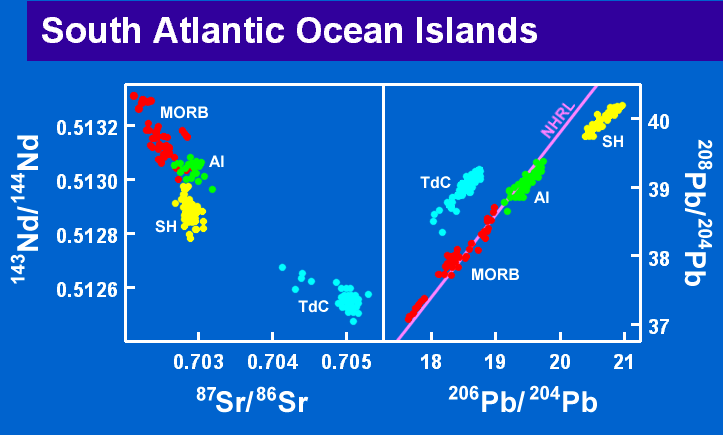Comparitive composition of volcanic rocks from Ascension, St. Helena, and Tristan
If you were given samples of typical "basalt" lava flows from Ascension, St. Helena, and Tristan you would be hard pressed to tell them apart visually. However, this superficial similarity hides some very significant (albeit subtle) differences in the chemical composition of the volcanic rocks of the three islands.
This can best be illustrated with two diagrams that highlight the chemical distinctions. But first, there's some necessary background:
- All rocks are composed of a wide range of chemical elements, some present at high concentration
(the so-called major elements), others present at low concentration (the so-called trace elements).
- When the interior (mantle) of the Earth melts to produce magma, the magma directly inherits
certain trace element characteristics of the mantle source. Consequently, chemical analysis of
a lava flow (solidified erupted magma) will reveal the trace element "fingerprint" of the source mantle that was melted.
- In addition, some trace elements have isotopes that are radioactive and (very!) slowly decay to isotopes of another element. Again, when the mantle melts the resultant magma directly inherits the isotopic composition of the mantle source, and analysis of a lava flow sample will reveal the isotopic "fingerprint" of the source mantle.
The first diagram (below) shows the trace element characteristics of typical rock (lava flow) samples from Ascension (AI), St. Helena (SH), and Tristan (TdC). Various trace elements are plotted on the horizontal (x) axis, and the concentration of each element is represented on the vertical (y) axis. The concentrations of adjacent elements are joined by a line to produce a trace element pattern for each sample. [The full chemical analyses for the rock samples are here.]

It's pretty obvious from looking at the trace element patterns in the diagram above (particularly the part of the pattern on the left hand side of the diagram) that the volcanic rocks of Asension, St. Helena, and Tristan have distinctly different trace element characteristics. The logical conclusion is that there is a different ultimate mantle source region for the lavas erupted on each island.
This is (perhaps more strikingly) confirmed by the second diagram (below; actually two side-by side diagrams) which shows the isotopic composition of rock samples from the three islands (multiple samples from each island are plotted on the diagrams).

The exact details of the isotopes plotted on the diagrams are less relevant than the observation that the isotopic compositions of the volcanic rocks of the three islands are clearly distinctly different [but if you really want the gory details go here].
Not only does this confirm different ultimate mantle sources for the lavas erupted on each island, but, because isotopic compositions change only extremely slowly, reveals that the different mantle source regions have been separate and isolated for very long periods of time (in fact, hundreds of millions of years are required for the different mantle sources to isotopically "mature").
Additionally, the isotopic composition of the volcanic rocks from Ascension, St. Helena, and Tristan is markedly different to that of submarine basalt samples recovered from the Mid-Atlantic Ridge (MORB - an acronym for mid-ocean ridge basalt - in the diagrams). Mid-ocean ridge basalt samples from around the world (Altantic, Indian, and Pacific Oceans) are similar in isotopic composition and are believed to represent the characteristics of the uppermost part of the mantle of the Earth.
So not only are the sources for Ascension, St. Helena, and Tristan magmas separate and distinct from each other, they also are separate and distinct from the upper mantle that is the source for mid-ocean ridge basalt magmas.
The key question then is exactly where and what are the source regions for hotspots?
The where is fairly straightforward. Seismic imaging of the mantle suggests that the most likely locations are at depths of about 700 km (the base of the upper mantle) and about 2900 km (the base of the mantle).
The what is more contentious. One possibility (the one I prefer!) is
that ancient plates (as in plate tectonics) recycled into the mantle (by the process known
as subduction) have accumulated deep (700 km or 2900 km) in the mantle. After perhaps one to one and a
half billion years of storage (during which time isotopic compositions have changed considerably) this material
becomes the source for hotspots. Depending on how much (if any) and what type of sediment was subducted
with a plate, the compositional characteristics of different hotspot sources could be quite variable.
For example, in the case of the South Atlantic islands, the trace element and isotopic characteristics
are consistent with a Tristan hotspot source that contains significant sediment, whereas the source of
the St. Helena hotspot has negligible, or no, sediment. The composition of the volcanic rocks of
Ascension reflects a St. Helena-type source that has been heavily diluted by an upper mantle component.
![]() Ascension geology
| St. Helena geology
| Tristan geology
Ascension geology
| St. Helena geology
| Tristan geology
Page maintained by Barry Weaver